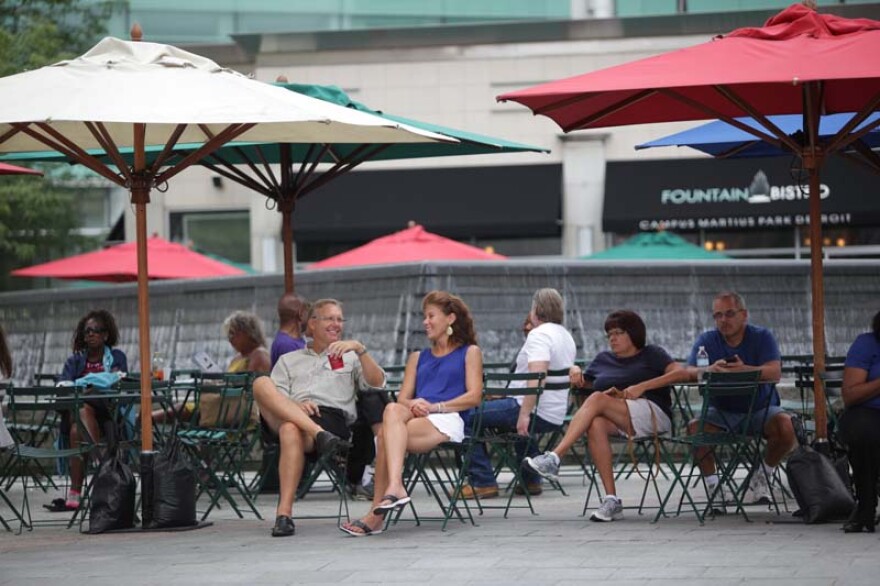Crime, education, unemployment, services – all have a direct bearing on urban life, and all are measurable in data, and trackable over time.
But what can be lumped into a category one might call “livability?” The factors that make a city appealing to ordinary residents, workers, families, young people and fun seekers aren’t so easy to quantify. As is typical in this city of extremes, residents enjoy rich bounties and suffer appalling deficits.
The community spirit that moves Detroiters to tattoo Old English D’s on their arms manifests in many ways. Block clubs in many neighborhoods look out for one another, mowing vacant lots and sharing barbecue in summer months. The city has a robust core of thousands of volunteers, who staff everything from hospital gift shops to soup kitchens, schools, animal shelters and community gardens.
The city’s cultural jewels run the gamut from ensembles and orchestras to Old Masters and African-American history, and myriad non-institutional artists fill parks and plazas with techno, country, heavy metal and performance art. Touring Broadway shows, community and children’s theater and film societies fill small halls and grand auditoriums. Four major-league sports teams play in the city or suburbs.
Detroit's parks are another story. Its tattered beauties - which include Belle Isle and Palmer Park - are starting to improve, as nonprofit conservancies take over operation and relieve the city of the financial burden of maintenance.
Detroit’s parks are another story. Its tattered beauties – which include Belle Isle and Palmer Park – are starting to improve, as nonprofit conservancies take over operation and relieve the city of the financial burden of maintenance. Elsewhere, scores of city parks have been closed, and many other neighborhood and even riverfront parks see little or no maintenance.
Likewise, many community and recreation centers, which once gave teens across this sprawling city a place to go and safe activities to enjoy, have been shuttered for years, with private money helping to keep the few remaining facilities open.
In the private sector, the picture is brighter, particularly downtown, in Corktown, Eastern Market and the central city. Campus Martius and New Center Park host cultural events year-round, and are kept clean and well-equipped. New eateries now keep Slow’s company along a once-desolate stretch of Michigan Avenue. The riverfront has been transformed into a strand of walkways and overlooks for pedestrians and cyclists.
But a lack of basic services – good schools, reliable public transit and trash pick-up, citywide blight removal and working street lights – are ongoing barriers to Detroit becoming a place where residents want to stay and others wish to live and work.
So too are high taxes, including property taxes, which Mayor Duggan just pledged would be going down, and the notorious cost of insurance, for both motorists and homeowners, which has led some to such subterfuge as registering their cars outside the city, a topic Bridge explored last year. The state has no hard data on exactly how much more Detroit residents pay, said Caleb Buhs, spokesman for the Michigan Department of Insurance and Financial Services. Anecdotally, Detroiters will claim they often pay twice what they would in the suburbs.
So there is much work ahead to make Detroit more attractive, more livable.
It is incumbent on city leaders – from Mayor Mike Duggan to City Council, Emergency Manager Kevyn Orr, Gov. Rick Snyder, Detroit clergy and other power brokers – to convince scandal-weary residents that they will have a role in Detroit’s recovery. A livable city is one in which ordinary people feel they have a voice in political, economic and social change. That means a real effort to bring transparency and accountability to public service. Bridge will be looking for signals that leaders are being more responsive to community voices, not just citywide but on a neighborhood level. City government must likewise be more responsive than in the past in providing quick and inexpensive access to public records.
For residents who have endured so much, even more will be asked. Improving Detroit’s quality of life requires engagement in all corners of the city – rebuilding neighborhoods, volunteering, keeping children on track in school and, in the ultimate test of civic duty, voting.
While these measures of livability are less quantifiable, Bridge will revisit them, and others, at regular intervals in the months ahead, to gauge Detroit’s path to recovery.
*This story originally appeared in Bridge Magazine
Support for the Detroit Journalism Cooperative on Michigan Radio comes from the John S. and James L. Knight Foundation, Renaissance Journalism's Michigan Reporting Initiative, and the Ford Foundation.





